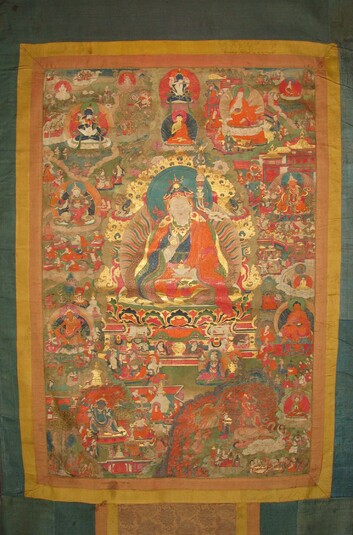
Item: Padmasambhava - (Main Form)
| Origin Location | Himalayan Region |
|---|---|
| Date Range | 1700 - 1799 |
| Lineages | Nyingma |
| Material | Ground Mineral Pigment on Cotton |
| Collection | Rubin Museum of Art |
Padmasambhava, Guru Rinpoche (Tibetan: pe ma jung ne. English: Lotus Born) the principal founder, along with Shantarakshita and King Trisong Detsen, of Buddhism in Tibet. [Padmasambhava Outline Page].
 Pemasambhava
Pemasambhava  Pema Jungne
Pema Jungne  Biographical Details
Biographical Details
At the center of the composition is Padmasambhava in his standard appearance as the Lotus Born. At the top center is Samantabhadra and consort, the Primordial Buddha according to the Nyingma Tradition of Tibetan Buddhism. Below that is Shakyamuni Buddha.
At the top left side is Orgyan Dorje Chang, blue in colour, seated, embraced by the Indian consort Madarawa. Below that is Loden Chogse dressed in royal garments, holding a damaru drum upraised in the right hand and a skull bowl in the left. Below that is Nyima Ozer, orange in colour, adorned with charnal ground ornaments. Below that is Sengge Dradog, wrathful, blue in colour and surrounded by flames.
At the top right side is Pema Jungne wearing monks robes and an Indian pandita hat. Below that is Pema Gyalpo dressed as a king and holding a damaru drum in the right hand and a mirror in the left. Below that is Shakya Sengge in the appearance of a Buddha with the right hand slightly raised and the left holding a black begging bowl in the lap. Below that is Dorje Drolo, reddish in colour, wrathful, standing atop a pregnant tigress.
Each of these surrounding images are the eight principal forms of Padmasambhava. They represent the important periods and events from the life-stoy of Padmasambhava and each form is further surrounded by narrative scenes representing specific key events.
The eight forms represented in this composition do not follow a chronological order of the events of Padmasambhava's life but are placed according to a visual hierarchy followed by many Tibetan artists. To view a painting that presents the life-story in a sequential order with the addition of other forms of Padmasambhava see painting #90161.
"Miraculous buddha arising from a lotus, unborn, undying, possessing a vajra body, performing the activity of all buddhas of the three times; homage to Padmasambhava." (Nyingma liturgical verse).
Considered principal among the many teachers to bring Buddhism to Tibet in the 8th century, Padmasambhava has numerous forms representing outer, inner and secret aspects. Within the Oral (Kama) Tradition of the Nyingmapa School, Padmasambhava was born in Northern India as the son of a king or minister. In the Treasure (Terma) Tradition he was born on a lotus in Dhanakosha lake in the kingdom of Orgyan (Uddiyan, Urgyan) as an emanation of Amitabha Buddha.
Jeff Watt 7-2006
Padmasambhava: Painting Masterworks (RMA)
Padmasambhava Main Page
Padmasambhava: Eight Forms & Life Story (Single Painting)
Collection of Rubin Museum of Art (RMA): Main Page
Padmasambhava: Life Story Main Page
Padmasambhava: Eight Forms (Single Painting)
Padmasambhava: Painting Masterworks
Collection of RMA: Best of Collection 2
